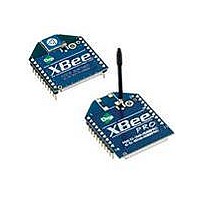XBP09-DPSIT-156 Digi International, XBP09-DPSIT-156 Datasheet - Page 28

XBP09-DPSIT-156
Manufacturer Part Number
XBP09-DPSIT-156
Description
MODULE XBEE PRO W/RPSMA
Manufacturer
Digi International
Series
XBEE-PRO™r
Specifications of XBP09-DPSIT-156
Frequency
902MHz ~ 928MHz
Data Rate - Maximum
156kbps
Modulation Or Protocol
FHSS
Applications
ISM
Power - Output
17dBm (50mW)
Sensitivity
-100dBm
Voltage - Supply
3 V ~ 3.6 V
Current - Receiving
80mA
Current - Transmitting
210mA
Data Interface
PCB, Through Hole
Antenna Connector
RP-SMA
Operating Temperature
-40°C ~ 85°C
Package / Case
Module
Lead Free Status / RoHS Status
Lead free / RoHS Compliant
Memory Size
-
Lead Free Status / Rohs Status
Lead free / RoHS Compliant
Other names
602-1169
XBee‐PRO® 900 RF Modules
Operation
Cyclic Sleep Mode (SM=8)
Sleep Support Mode (SM=7)
Synchronization Messages
A node in cyclic sleep mode sleeps for a programmed time, wakes in unison with other nodes,
exchanges data and sync messages, and then returns to sleep. While asleep, it cannot receive RF
messages or read commands from the UART port. Generally, sleep and wake times are specified
by the SP and ST of the network's sleep coordinator respectively. These parameters are only used
at start-up until the node is synchronized with the network. When a module has synchronized with
the network the sleep and wake times it is using can be queried with the OS and OW commands
respectively. If D9 = 1 (ON_SLEEP enabled) on a cyclic sleep node the ON_SLEEP line will assert
when the module is awake and de-assert when the module is asleep. CTS is also de-asserted while
asleep (when D7 = 1).
An unsynchronized sleeping node, newly powered, will poll for a synchronized message and then
sleep for the period specified by SP, repeating the cycle until it becomes synchronized by receiving
a sync message. Once a sync message is received, the node will synchronize itself with the
network.
A node in sleep support mode will synchronize itself with a sleeping network but will not sleep. At
any time the node will respond with a sync message to new nodes in range which are attempting
to join the sleeping network. A sleep support node will only transmit normal data when the nodes
in the sleeping network are awake.
Sleep support nodes are especially useful when used as preferred sleep coordinator nodes and as
aids for adding new nodes to a sleeping network.
Note: Because sleep support nodes do not sleep they should be mains powered.
One node in a sleeping network acts as the sleep coordinator. The process by which a node
becomes a sleep coordinator is described later in this document. During normal operations, at the
beginning of a wake cycle the sleep coordinator will send a sync message as a broadcast to all
nodes in the network. This message contains synchronization information and the wake and sleep
times for the current cycle. All cyclic sleep nodes receiving a sync message will remain awake for
the wake time and then sleep for the sleep period specified.
The sleep coordinator will send one sync message at the beginning of every cycle with the
currently configured network wake and sleep times. All router nodes which receive this sync
message will relay the message to the rest of the network. If the sleep coordinator does not hear
a re-broadcast of the sync message by one of its immediate neighbors then it will re-send the
message one additional time. It should be noted that if SP or ST are changed the network will not
apply the new settings until the beginning of the next wake time. See the Changing Sleep
Parameters section below for more information.
A sleeping router network is robust enough that an individual node can go several cycles without
receiving a sync message (due to RF interference, for example). As a node misses sync messages
the time available for transmitting messages in the wake time is reduced to maintain
synchronization accuracy. By default a module will also reduce its active sleep time progressively
as sync messages are missed.
A sleep coordinator will regularly send sync messages to keep the network in sync. Nodes which
have not been synchronized or, in some cases, which have lost sync will also send messages
requesting sync information.
Deployment mode is a mode that sleep compatible nodes employ when they are first powered up
and the sync message has not been relayed. A sleep coordinator in deployment mode will rapidly
send sync messages until it receives a relay of the sync message that it has sent. This allows a
network to be deployed more effectively and allows a sleep coordinator which is accidently or
intentionally reset to rapidly re-synchronize with the existing network. If a node which has exited
deployment mode receives a sync message from a sleep coordinator which is in deployment mode
© 2009 Digi International, Inc.
28














